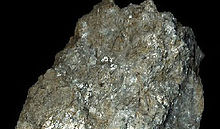Sericite is the name given to very fine, ragged grains and aggregates of white (colourless) micas, typically made of muscovite, illite, or paragonite.[1] Sericite is produced by the alteration of orthoclase or plagioclase feldspars in areas that have been subjected to hydrothermal alteration typically associated with copper, tin, or other hydrothermal ore deposits. Sericite also occurs as the fine mica that gives the sheen to phyllite and schistose metamorphic rocks.

A sample of sericite
The name comes from Latin sericus, meaning "silken" in reference to the location from which silk was first utilized, which in turn refers to the silky sheen of rocks with abundant sericite.
- Sericite in thin section (fine, high birefringence flakes covering other larger minerals)


| This article uses material from the Wikipedia article Metasyntactic variable, which is released under the Creative Commons Attribution-ShareAlike 3.0 Unported License. |